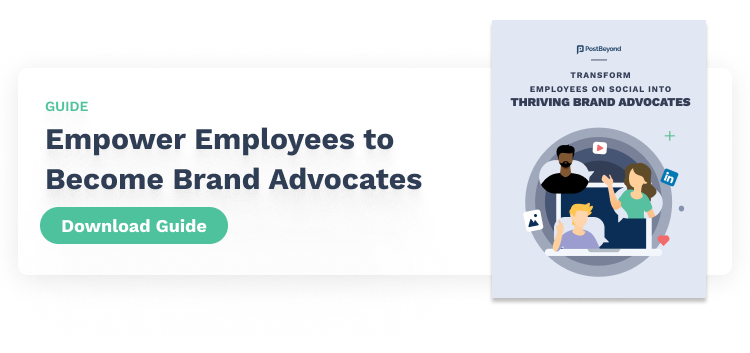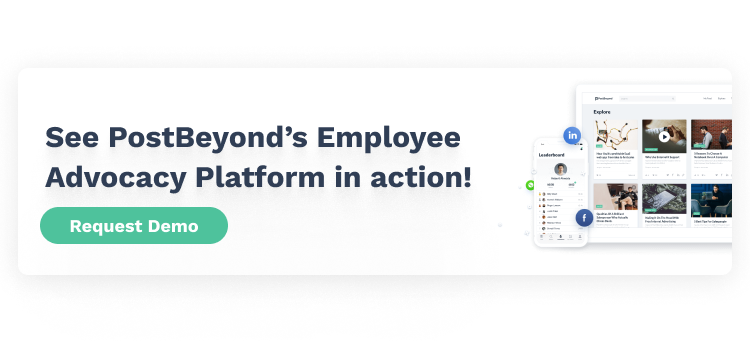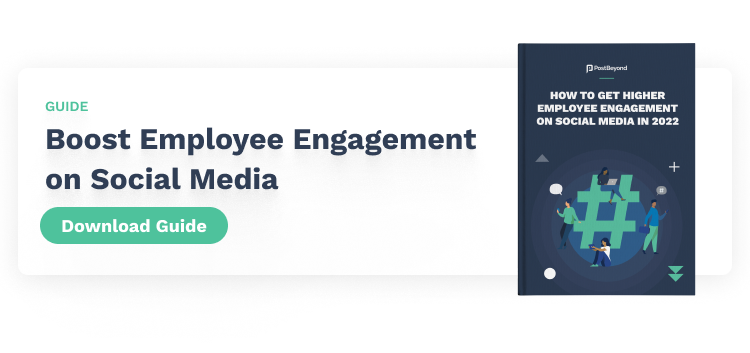Last week, Chris Kim (Director of Social Media at Airtable) joined us to walk us through his journey managing employee advocacy programs. From reflecting on the evolution of social media to fine-tuning training for employees to winning over executives, Chris provided us a glimpse into how he starts and scales employee advocacy to unlock the brand amplification power of employees and social media.
You can catch the full interview – done by our very own Sarah Beatty (Manager of Customer Success at Influitive) – here. Read on to get a high-level recap:
First, a Little About Chris and His Journey
Chris has been a social media program leader for nearly 15 years. He’s worked for a wide variety of companies in the tech space, such as Intuit, SAP, Workday, Hitachi Vantara, and ServiceNow before leading up social media at Airtable.
In that time, Chris saw social media platforms emerge and evolve. Not only that, but he’s also seen the growth of digital communities. Interestingly, Chris originally began his work on social media by engaging customers and employees on discussion forums and blogs.
This gave Chris the lens to find where people consume content, interact, and build relationships that can have an impact on businesses.
Chris started hearing about employee advocacy nearly 10 years ago. Social media marketers at the time were figuring out how to leverage rising platforms (like LinkedIn). Organic reach was – and still is – something marketers wanted to harness.
Hence, Chris and other early marketers looked to employees to (as we see from the stories of our other customers) help fuel that organic reach. For Chris, this started by sending emails or newsletter to employees with links, suggested copy, and CTAs to share posts. And as these employee advocacy programs grew in scope and complexity, Chris sought dedicated tools to automate, measure, and drive wide-scale enablement.
Today, Chris is seeing algorithms shift to favoring user-generated content (UGC). As a result, the world of employee advocacy is moving towards leaning on employees for both distribution and, increasingly, original content creation.
So, what should employee advocacy program managers do to leverage these shifts? Read on to see how Chris is doing it:
1. How Do You Start an Employee Advocacy Program?

Start With a Company-Wide Policy
Chris recommends starting with a social media policy for the whole company. It doesn’t need to be fully baked at first. But as an internal-facing asset, the policy helps encourage the wider team to engage on social media. It offers unsure or worried employees a runway to take off on social by defining what’s allowed/not allowed, tips, and other guidance.
Follow Up With Role-Specific Training
Next, follow up with role-based training. Chris starts by supporting customer and external-facing teams that have the most to gain from being active on social. This usually centers on marketing, sales, and HR/people ops teams. Equip them with the tactics and resources they need to drive reach, build their personal brands, forge relationships, and hit their departmental KPIs.
Introduce a Tool to Provide Enablement
Chris recommends launching a dedicated employee advocacy platform. It gives employees a sense of enablement – like a centralized place to find content, get templates, and re-share.
2. How Did You Train Your Employees on Social Media?

Set the Foundation for Everyone
Chris says you should start by messaging the whole company. Talk about how everyone on the team is an ambassador for the brand. Get people excited about employee advocacy.
Next, use your existing internal channels to reinforce the message.
You probably use Slack or Teams. Chris uses those to announce new campaigns, upcoming events, assets, and other news.
Chris also works with the HR or People Ops teams to get new hires familiar with the company’s employee advocacy efforts. This is a great way to drive early awareness and interest.
Once you set the foundation, move towards role-specific training of your external-facing teams.
Sales Team
Your salespeople want others to see them as credible experts and problem-solvers, not “just another rep.” This is one of the goals of social selling, a strategy that leverages social to find and connect with prospects, build relationships, and drive trust before the first call.
When training the sales team, Chris recommends partnering with the sales enablement lead at your company. It’s a good idea to avoid doing something separate. In fact, chances are that the sales team already has established processes in place, like a bootcamp, weekly call, newsletter, and Slack channel. Try working within these processes to help them onboard to your program.
HR/People Ops Team
From sourcing new talent to engaging employees, your HR/People Ops team uses social in a variety of ways. Focus on helping them with activities that attract job prospects, build personal brands, and drive brand awareness.
Marketing Team
Chris saw that his marketing team’s networks were literally the exact target market of Airtable (itself a martech company). So, it was easy to internally sell employee advocacy to this group as they understood the value of engaging with their networks.
However, in general, marketing teams want scalable ways of creating strong content and, just as importantly, distributing it far (and fast). In an age where audiences want to hear from other people (and not brands), employee advocacy is a natural fit.
Overall, in any company, Chris noted that you’ll want to account for two things:
First, things will vary based on the organization’s culture. Each company works in unique ways, so be flexible – but do your best to work within existing channels.
Second, make sure you’re answering the “what’s in it for me?” question. Show each team how employee advocacy ties into supporting departmental KPIs and personal career goals.
3. How Did You Motivate the Company?

Chris found that it depends on the specific teams you’re working with. For example, sales are a competitive bunch. You can use gamification, contests, and prizes to drive their interest.
One thing Chris found useful across all teams is getting people from within those groups to speak about employee advocacy. Teammates want to hear from their immediate peers about how social media helped them, be it with KPIs or personal aspirations. Look for these ‘internal influencers’ to help drive support for your program.
4. What KPIs Did You Set for Your Employee Advocacy Program?

Chris brought up the conventional metrics – like platform adoption, shares, reach and so on. But it’s important to put those metrics into context.
For example, when Chris talks about shares to leadership, he highlights how employee shares drive more reach than shares from official brand accounts. So, if the goal is to drive awareness on social media, Chris proves that employees create more of that than other mediums.
Chris also recommends leaning on qualitative stories. For example, put the spotlight on one of your sales executives who used advocacy to build their personal brand, connect with prospects and secure meetings.
Chris also ties his target metrics to key departmental goals and KPIs. One example he brought up was setting up processes to see how employee shares impact form fills for demand gen.
When asked about earned media value (EMV), a metric offered on the PostBeyond platform, Chris says not to lean on it alone. Again, tell a story of how employee advocacy drives tangible outcomes. For example, when highlighting how employee shares drive more reach than official accounts, put a dollar figure on the value of that reach using EMV.
5. How Do You Mobilize Executives on Social Media?

Chris agreed that having executives on social is super valuable. Anytime a leader engages on social, people rally around them, and it helps nurture a culture of sharing. It’s powerful.
But convincing them isn’t easy, as Chris said, “I wish there was a magic bullet for this one.”
Ultimately, you’ll have a range of people. Some executives are already active on social and “get it.” Others are a bit more shy, humble, or reserved.
In principle, you don’t want to force anyone to do anything they don’t want to do. Instead, build a crawl-walk-run type of ramp that starts with an easier task.
Maybe encourage executives to start by sharing company news or amplifying an event. From there, suggest ideas, like sharing their accolades, talking about proud moments, commenting on their colleagues’ posts and so on. Chris eventually comes across leaders who want to engage, but they might ask for help in drafting a post.
Humble executives might not like touting their own horn. However, you can encourage them to talk about their fellow executives and employees at the company. This is a really good way for the executive to get active on social and drive employee enthusiasm by spotlighting the team in positive ways.
Bonus: Where’s Social Media Going in 2023?
In 2022, Chris noticed that more and more Twitter and Instagram creators were migrating onto LinkedIn. This shift in content creators and audiences may drive changes in LinkedIn. We think this resonates with a point Laura (from Dreamdata) made about experimenting with TikTok-style videos on LinkedIn. The fact that TikTok’s style is starting to resonate with people on LinkedIn can speak to an evolution in the platform and its members.
Chris also highlighted the emergence of communities in LinkedIn. He’s not talking about pages or groups. Rather, the communities exist within the comments of every post. So, as people have conversations in the comments, they’re building communities based on those discussions.
Astute social media managers should think about how they can create communities through their employee networks. This will definitely require elevating employees into thought leaders, encouraging people to drive discussions on LinkedIn, and create authentic content.

Top Audience Questions
1. How Do You Encourage Skittish Employees/Executives to Come Online?

2. Should Social Media Training be Mandatory?

3. How Do You Compensate Employee Advocates?

4. Do You Invest in Writing Posts That DON’T Promote the Company?

5. How Do You Keep Your Employee Advocates Engaged?







